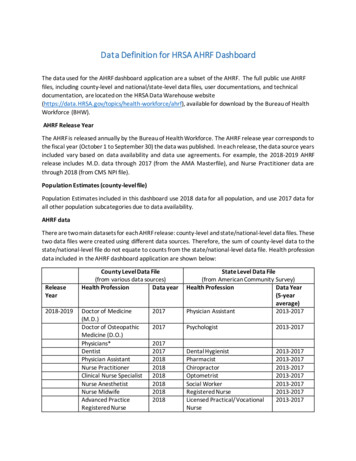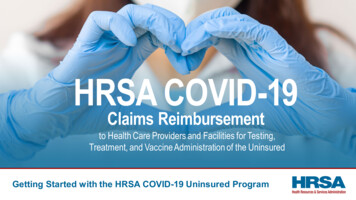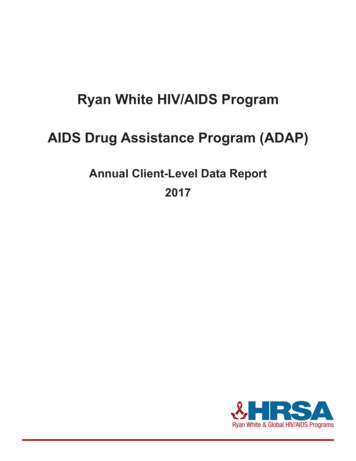
Transcription
Data Definition for HRSA AHRF DashboardThe data used for the AHRF dashboard application are a subset of the AHRF. The full public use AHRFfiles, including county-level and national/state-level data files, user documentations, and technicaldocumentation, are located on the HRSA Data Warehouse rce/ahrf), available for download by the Bureau of HealthWorkforce (BHW).AHRF Release YearThe AHRF is released annually by the Bureau of Health Workforce. The AHRF release year corresponds tothe fiscal year (October 1 to September 30) the data was published. In each release, the data source yearsincluded vary based on data availability and data use agreements. For example, the 2018-2019 AHRFrelease includes M.D. data through 2017 (from the AMA Masterfile), and Nurse Practitioner data arethrough 2018 (from CMS NPI file).Population Estimates (county-level file)Population Estimates included in this dashboard use 2018 data for all population, and use 2017 data forall other population subcategories due to data availability.AHRF dataThere are two main datasets for each AHRF release: county-level and state/national-level data files. Thesetwo data files were created using different data sources. Therefore, the sum of county-level data to thestate/national-level file do not equate to counts from the state/national-level data file. Health professiondata included in the AHRF dashboard application are shown below:ReleaseYear2018-2019County Level Data File(from various data sources)Health ProfessionData yearDoctor of Medicine(M.D.)Doctor of OsteopathicMedicine (D.O.)Physicians*DentistPhysician AssistantNurse PractitionerClinical Nurse SpecialistNurse AnesthetistNurse MidwifeAdvanced PracticeRegistered Nurse2017State Level Data File(from American Community Survey)Health ProfessionData Year(5-yearaverage)Physician Assistant2013-20172017Psychologist2013-2017Dental HygienistPharmacistChiropractorOptometristSocial WorkerRegistered NurseLicensed Practical/ 1820182018
Physical Therapist2013-2017Occupational Therapist2013-2017Respiratory Therapist2013-2017Speech Language Pathologist2013-2017Dietitian and Nutritionist2013-2017EMT and Paramedic2013-2017* Physician include both Doctor of Medicine (M.D.) and Doctor of Osteopathic Medicine (D.O.)Clinician Rate (per 100,000 population)Clinician rate used in this application is calculated as clinician count divided by the respective population.The result then is multiplied by 100,000.Data NoteWhen data is not available or suppressed, it is shown in this application as NA (not applicable).AHRF County-Level Data File DefinitionCounty-Level data for selected health professions used in this application come from various data sourcesand include 50 U.S. state, District of Columbia, Puerto Rico, U.S. Virgin Island and Guam. Physician data are from the 2017 American Medical Association (AMA) MasterfileThe AMA Physician Masterfile was initially developed as a record keeping device supportingmembership and mailing activities. It has expanded to include significant education, training andprofessional certification information on virtually all Doctors of Medicine (MD) and Doctors ofOsteopathic Medicine (DO) in the United States, Puerto Rico, Virgin Islands and certain PacificIslands.Dentist data are from the 2017 American Dental Association (ADA) MasterfileThe American Dental Association (ADA) Masterfile includes a census of all professionally activedentists in the United States, Puerto Rico, Virgin Islands and Guam.Nurses and Physician Assistant data are from the 2018 Centers for Medicare and Medicaid Serves(CMS) National Provider Identification (NPI) fileThe CMS NPI File contains FOIA disclosable National Plan and Provider Enumeration System(NPPES) health care provider data for health care providers who have been assigned NationalProvider Identifiers.Health Profession DataPhysicians (AMA Masterfile) Physician fields contain only active physicians with classified major professional activity, unlessspecifically stated that inactive and/or not classified are included. Physician include both Doctorof Medicine (M.D.) and Doctor of Osteopathic Medicine (D.O.).Inactive Status includes physicians who are retired, semiretired, working part‑time, temporarilynot in practice, or not active for other reasons and indicated they worked 20 hours or less perweek.Not Classified Status includes physicians who did not provide information on their type of practiceor their present employment.
Federal Status is defined as full‑time employment by the federal government, including the Army,Navy, Air Force, Veteran's Administration, the Public Health Service and other federally fundedagencies.Primary Care includes General Family Medicine, General Practice, General Internal Medicine andGeneral Pediatrics. Subspecialties within these specialties are excluded.Dentist (ADA Masterfile) Dentist includes professionally active dentists whose primary occupation is dental related. Thisincludes Full-time and Part-time Private Practice; Dental School Faculty; Armed Forces; OtherFederal Service; State or Local Government; Hospital Staff Dentist; Graduate Student/Resident;Other Health/Dental Organization Staff; and Part-Time Faculty/Part-Time Practice. Only thoseidentified as active and licensed are included.Physician Assistance (CMS NPI file) Physician assistants are formally trained to perform many of the routine, time-consuming tasksa physician can do. In some states, they may prescribe medications. They take medical histories,perform physical exams, order lab tests and x-rays, and give inoculations. Most states require thatthey work under the supervision of a physician.National Provider Identification (NPI) is a unique identifier developed by CMS. Covered healthcare providers and all health plans and health care clearinghouses must use the NPIs in theadministrative and financial transactions adopted under HIPAA.Nurses (CMS NPI file) Advanced Practice Registered Nurse (APRN) is a registered nurse having education beyond thebasic nursing education and certified by a nationally recognized professional organization in anursing specialty, or meeting other criteria established by a Board of Nursing. APRN includesadvanced practice midwife, certified registered nurse anesthetist, clinical nurse specialist, andnurse practitioner.Nurse Practitioner is a registered nurse provider with a graduate degree in nursing prepared foradvanced practice involving independent and interdependent decision making and directaccountability for clinical judgment across the health care continuum or in a certified specialty.Nurse practitioner specialists include, but are not limited to, family nurse practitioners,gerontological nurse practitioners, pediatric nurse practitioners, obstetric-gynecologic nursepractitioners, and school nurse practitioners.Certified Registered Nurse Anesthetist (CRNA) is a licensed registered nurse with advancedspecialty education in anesthesia who, in collaboration with appropriate health care professionals,provides preoperative, intraoperative, and postoperative care to patients and assists inmanagement and resuscitation of critical patients in intensive care, coronary care, and emergencysituations. A CRNA is qualified by special training to administer anesthesia in collaboration with aphysician or dentist and who can assist in the care of patients who are in critical condition.Nurse Midwives includes both certified nurse-midwives (CNMs) and certified midwives (CMs).Midwifery practice is the independent management of women's health care, focusingparticularly on pregnancy, childbirth, the post-partum period, care of the newborn, and thefamily planning and gynecologic needs of women. The CNM and CM practice within a health
care system that provides for consultation, collaborative management, or referral, as indicatedby the health status of the client.Clinical Nurse Specialist is a registered nurse who, through a graduate degree program in nursing,or through a formal post-basic education program or continuing education courses and clinicalexperience, is expert in a specialty area of nursing practice within one or more of the componentsof direct patient/client care, consultation, education, research and administration.National Provider Identification (NPI) is a unique identifier developed by CMS. Covered healthcare providers and all health plans and health care clearinghouses must use the NPIs in theadministrative and financial transactions adopted under HIPAA.Population DataCensus County Population Estimates: Each year, the Census Bureau's Population Estimates Program usescurrent data on births, deaths, and migration to calculate population change since the most recentdecennial census and produces a time series of estimates of population, demographic components ofchange, and housing units.Census County Characteristic File: Each year, the Census Bureau produces and publishes estimates of thepopulation for the nation, states, counties, state/county equivalents, and Puerto Rico. The countycharacteristic file provides estimates of states and counties by age, sex, race, and Hispanic origin.Census Small Area Income and Poverty Estimates (SAIPE): The Census Bureau's SAIPE program providesannual estimates of income and poverty statistics for all school districts, counties, and states. It is designedto provide estimates of income and poverty for the administration of federal programs and the allocationof federal funds to local jurisdictions.State-level Data File DefinitionState-Level Data used in this application come from the American Community Survey (ACS), 2013-2017 5year Public Use Microdata Sample (PUMS) File. The ACS, an annual household survey, provides detailed self-reported data about U.S. householdand persons, including information on individuals working across various industries andoccupations. It is the major source of data for AHRF state-level data file.Health occupations included are classified based on the U.S. government’s 2010 StandardOccupational Classification (SOC) system.The “workforce” is defined as individuals aged 16 who worked within the previous five years.Does not new workers (persons seeking employment for the first time and who had not yetsecured their first job). All counts include 50 U.S. states and District of Columbia.For employed individuals, the occupation refers to the person’s job during the previous week. Forthose who worked two or more jobs, the occupation refer to the job where the person workedthe greatest number of hours (primary job).For unemployed individuals and those who are not currently employed but report having a jobwithin the last five years, the data refer to their last job.ACS data are suppressed for any value where the percent relative standard error (PRSE) is greaterthan 30%. When data is suppressed, it is shown as NA (not applicable) in this dashboardapplication.
Health Profession DataOnly selected health professions from the AHRF state-level data file are included in this application. Thetable below list selected health profession and associated SOC codes.ProfessionSOC CodePhysician AssistantsRegistered NursesLicensed Practical and Licensed Vocational NursesDental sSocial WorkersPhysical TherapistsOccupational TherapistsRespiratory TherapistsSpeech-Language PathologistsDietitians and Nutritionists29-104119-303021-1020 where NAICS Industry Code is Medical Settingand Individual and Family 9-1031Emergency Medical Technicians and Paramedics29-2041Population DataPopulation data used in this application came from 2013-2017 5-year Public Use Microdata Sample (PUMS)File.
Nurse Practitioner 2018 Chiropractor 2013-2017 Clinical Nurse Specialist 2018 Optometrist 2013-2017 Nurse Anesthetist 2018 Social Worker 2013-2017 Nurse Midwife 2018 Registered Nurse 2013-2017 Advanced Practice Registered Nurse 2018 Licensed Practical/ Vocational Nurse 2013-2017










